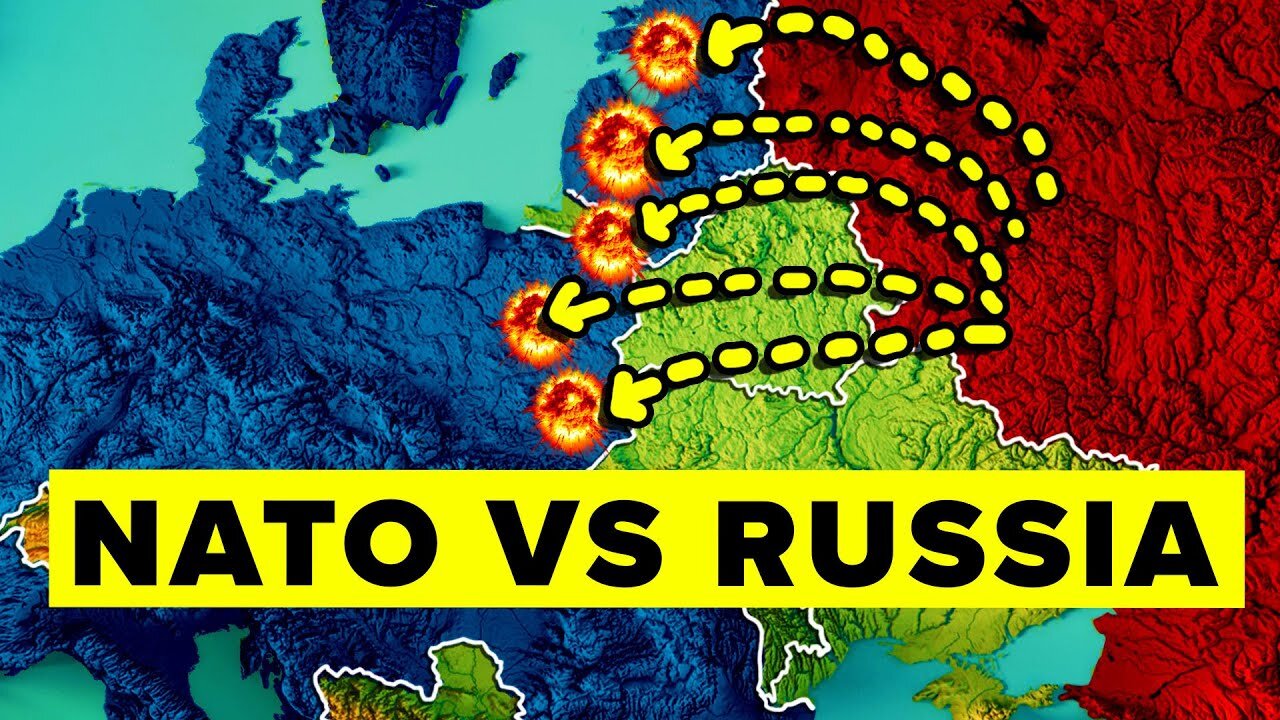Premium Only Content

If NATO and RUSSIA Go To War, Who Loses (Hour by Hour)
Experience the hypothetical scenario of a NATO-Russia war hour by hour, exploring the geopolitical tensions, military strategies, and potential outcomes. As the conflict unfolds, witness the intense battle for Lithuania and the Baltic States, where NATO forces face off against a determined Russian invasion. 🌐💥 Dive deep into the military capabilities, cyber warfare, and nuclear deterrence strategies of both sides. Who will emerge victorious, and at what cost? Join us for a gripping analysis of this high-stakes confrontation. Don't forget to share your thoughts in the comments below! #NATOWar #RussiaNATOConflict #Geopolitics #MilitaryStrategy #CyberWarfare #NuclearDeterrence #NATO #USA #america #russia #baltics #balticsea #skandinavien #latvia #lithuania #estonia
0:00
A war between Russia and NATO might seem impossible. After all, NATO currently consists
0:05
of 32 member countries, including the United States, Canada, the United Kingdom, and most
0:11
of Europe. Collectively, NATO forces dwarf those of Russia, both in terms of quantity and quality.
0:17
So, how could a NATO/Russia war possibly come to pass? Well,
0:21
as uncomfortable as it might be to consider, there are a few possibilities. For example,
0:26
as very nearly came to pass in the 1980s, - what if a NATO war game was misinterpreted by Russian
0:32
intelligence as cover for an assault on the motherland, leading to a pre-emptive strike? What
0:36
if Russia decided to invade a smaller member state on its border, pushing the red lines and seeing
0:41
if NATO – most importantly, the US – responded? The history between Russia and NATO has long been
0:48
tense. Despite a brief thaw after the collapse of the Soviet Union and the end of the Cold War,
0:53
these tensions are back at a deep freeze. In fact, relations are arguably the worst
0:58
they’ve been for half a century. Some have said we’re in a New Cold War.
1:02
Join us as we delve into this hypothetical matchup and scenario, which aims to illustrate one key
1:07
point: the US’s involvement and leadership are critical. Without it, who knows what might happen?
1:14
Hour 0 After years of planning, Putin’s generals give
1:17
the go-ahead. They want a much further divide between Russian borders and NATO countries.
1:22
Their target? Lithuania and the Baltic States. Taking Lithuania cuts Latvia and Estonia off
1:28
from Europe, leaving them primed and ready for a further Russian advance.
1:32
It’s not just a territorial expanse, though. The Russians feel utterly betrayed by NATO,
1:37
and the US in particular. As the Soviet Union collapsed, NATO officials had indicated – but
1:42
not in any legally binding manner – that NATO would avoid further eastward expansion,
1:47
ensuring the new Russia didn’t feel vulnerable. But it had reneged on that apparent promise,
1:51
and Russia was – and still is – deeply angry. Any potential trust was dead in the water as soon
1:57
as any countries bordering Russia joined NATO, leading to the inevitable re-escalation of tension
2:03
and the potential for a new cold – or hot! – war. The ongoing war in Ukraine hasn’t gone as planned.
2:09
As of early-mid 2024, Russian armed forces have taken a beating, with only around 1,750 tanks
2:16
left in operational service – and that includes a few antiques! It has around 1,200 bombers,
2:22
fighters, and attack aircraft left. But Russia must never be underestimated.
2:26
Its infantry is even larger than in 2022, at the start of the Ukraine War. And despite significant
2:32
equipment and vehicle losses, the production chain is ramping up, and close relations
2:36
with allies like China and Iran mean more and more are piling into the inventory every day.
2:42
After months of testing and probing, including airspace and naval violations,
2:47
as well as amassing troops on the border, Russia has seen little military response from Lithuania’s
2:51
NATO allies. Western leaders have verbally condemned Russia’s thinly veiled threats. Yet,
2:57
nobody has sent missiles, ships, jets, or reinforcements to their small ally.
3:02
Ok. Hour 0 rolls around. Judgement time. It’s the middle of the night. The few hundred
3:08
tanks Russia has left, removed from the war in Ukraine, are lined up on Lithuania’s border.
3:13
They fire up their engines and, escorted by 100,000 troops, mostly newly conscripted,
3:18
approach the crossings. Simultaneously, GPS and radar jamming cripples Lithuanian navigation and
3:24
communication systems, protecting the Russian soldiers and armaments from most missiles.
3:29
Russia launches a barrage of thousands of sea- and air-launched missiles along with
3:33
Iranian-built drones, first using its weaker, cheaper, and more disposable subsonic models.
3:39
Lithuania has very few air defence units, and NATO hasn’t finished ratifying the deal that will see
3:44
the country host its more advanced launchers. The country’s aerial defences will be swiftly
3:48
overwhelmed, at which point the supersonic and hypersonic arsenal will come into play.
3:53
Simultaneously, Russia launches its spare fourth- and fifth-generation fighter jets, including older
3:58
Sukhoi-27s and MiG-29s, as well as their newer counterparts, the Su-30s, Su-35s, and a couple
4:05
of brand new Su-57s. The Lithuanian Air Force, the LTAF, has no chance. No matter how excellent their
4:12
training is, the numbers are overwhelming. Their 6 or so active aircraft are mostly helicopters and
4:18
transport planes, no match for modern multipurpose jets. Although the long-range radar stations in
4:23
the east of the country see the Russians coming a mile off, there’s nothing they can do. The jets
4:27
are on top of them almost immediately, heading straight for the LTAF air base in Šiauliai.
4:33
Russia has two primary goals and two secondary objectives. First,
4:37
it seeks to take Vilnius, the Lithuanian capital near its border, before NATO can respond. Second,
4:43
it will aim to seize land between Belarus and Poland, slowing NATO land advances. Then,
4:47
if it can conquer all three Baltic states without triggering nuclear war, it will have significant
4:52
access to the Baltic and a much greater barrier between itself and NATO advances. And finally,
4:58
even if it all comes to naught, Putin will learn an awful lot about how NATO conducts war.
5:03
Lithuania’s intelligence division, the VSD, has expected this move for some time. After all,
5:08
why else would an openly threatening country line its troops up on the border? However,
5:13
Lithuania’s pleas for assistance to NATO allies have previously been swept under
5:17
the rug. Nobody else believed Russia would start another war, especially considering its
5:21
ongoing losses in Ukraine. How wrong they were.
5:24
Hour 1 The attack has
5:26
been strategically timed. Almost all NATO leaders around the world are asleep or preparing for bed.
5:31
Only the American president and Canadian prime minister are still awake, but they’re enjoying
5:35
rare peaceful evenings with their families. But intelligence operatives are wide awake.
5:40
All around the world, NATO leaders are urgently roused from their slumber and immediately summoned
5:45
to high-security meetings. They’re informed of Russia’s invasion. The British prime minister,
5:50
French president, and German chancellor sleepily try to grasp the severity of the situation.
5:55
At the same time, their two North American counterparts hold their heads in their hands:
5:59
the world is on the brink of war, and Article 5 of the NATO Agreement forces their retaliation,
6:04
along with 26 other countries and, of course, Lithuania itself.
6:08
But, legal obligations aside, is an aggressive retaliation a plausible response? Will it save
6:14
lives? Or, most crucially of all, will it risk triggering an all-out nuclear war,
6:18
mutually assured destruction of all major powers, and millions of unnecessary casualties?
6:23
The NATO Response Force, the NRF, and its 40,000 troops are primed and ready to respond. They’ve
6:28
been training for this and know that NATO can quickly mobilise a further 300,000 soldiers,
6:33
with millions more prepared to be called up. But it needs the go-ahead. It can’t
6:37
act without authorization from the top. And the NATO leaders have a dilemma. NATO
6:42
was implemented to deter Soviet expansion and aggression, seeking to prevent conflict.
6:47
Now that war has started anyway, they face an unprecedented situation. How should they respond?
6:52
Hour 2 NATO negotiators immediately
6:55
try to open communication channels with the Kremlin. They’re deeply concerned about the risk
7:00
of worldwide nuclear war and outright destruction. But nobody answers. And because nobody answers,
7:05
NATO leaders are at a loss for what to do. In fact, in Russia, Putin and his generals are
7:11
purposefully ignoring the ringing red hotline, waiting to see how the West will respond.
7:16
What move will they make? Until such a time, they’ll continue with the invasion as planned.
7:20
Meanwhile, as dawn approaches, odd things start happening in industries throughout Lithuania
7:25
and its Baltic State neighbours, Estonia and Latvia. Breakers in power substations around
7:29
the countries start mysteriously flipping off. Bank networks go offline. Port gates stop working,
7:35
and strange messages appear on the phones of government officials and contractors. Before long,
7:39
the vast majority of computers display nothing more than a black screen and
7:43
a ransom message demanding Bitcoin payment. On the surface, it looks like an independent
7:48
extortionist hacking group, but the strategic timing leaves few in doubt. Russia’s elite
7:53
hackers, such as the elusive GRU group known as Sandworm, are almost certainly behind the carnage.
7:59
As Lithuanians wake up in a war, they find their heating and air conditioning systems
8:03
offline. No matter; they’ve survived far more than the relatively mild discomfort caused by
8:08
a spring attack on infrastructure like this. But they soon find it’s far more than their systems.
8:13
Most of the power remains out, preventing streetlights from working, electric cars
8:17
from charging, and shops from opening. Even more dangerously, software helping
8:22
the armed forces direct their personnel and organise strategic moves is utterly destroyed,
8:27
along with all its backups. Its leaders and soldiers are resilient,
8:30
though, and they turn to less conventional methods to facilitate communication. These
8:35
include WhatsApp communications through satellite WiFi and even runners carrying notes to and fro.
8:41
Hour 3 Lithuanian forces continue to
8:43
engage the Russian onslaught, but there is very little they can do without NATO support. Brave
8:48
soldiers take out Russians at a ratio of more than five to one. Still, the relentless wave of humans
8:53
and machinery just keeps coming. Eventually, the self-sacrificial defenders are forced to fall back
8:58
or risk being overwhelmed and wiped out. Where are its allies? Where is NATO?
9:04
NATO is deliberating. European leaders are, by now, wide awake and beginning
9:08
to plan countermeasures. Despite the encroaching night, President Biden and
9:12
Prime Minister Trudeau in North America down strong coffees and continue to work.
9:16
Here’s the broader situation. Britain and France, two of the strongest European powers, have nuclear
9:21
weapons of their own. Other countries, including Germany, Italy, and Belgium, have American nukes
9:26
stationed within their borders. They’re all poised and ready to fire them if necessary. But doing so
9:32
would have catastrophic consequences. Despite Russia’s significant losses of
9:36
personnel and equipment in Ukraine and now Lithuania, it still maintains the largest
9:40
arsenal of nuclear weapons in the world, with 5,580 warheads as of 2024. Of these,
9:47
1,710 are deployed and ready to be launched on a missile or loaded onto a bomber at a moment’s
9:53
notice. The world’s other nuclear superpower, the US, held 3,708 as of 2023, with 1,419 deployed.
10:03
In contrast, the world’s other nuclear powers hold relatively meagre numbers. Again, in 2023,
10:08
China had 410, the UK had 225, France held 290, Pakistan had 170, India 164, Israel 90,
10:18
and North Korea about 30. While these numbers may pale in comparison, especially considering that
10:24
most are likely not actively deployed, note that modern nuclear weapons are often 50 to 100 times
10:29
more powerful than those dropped on Japan at the end of World War II. If just one hits its intended
10:35
target, the damage would be unfathomable – too great for the human brain to even comprehend.
10:41
That’s why NATO is carefully considering its next move. Russia is unpredictable right now,
10:46
testing the waters and seeing what it can get away with. It’s looking for a
10:49
fight – but it doesn’t have a death wish. NATO leaders – and most importantly,
10:53
the US – must choose their play carefully. The discussions are tense and drag on. All the while,
10:58
Lithuanian soldiers are being pushed further and further back, with ground
11:02
forces entering the outskirts of Vilnius. The tragic deaths are mounting.
11:07
Hour 4
11:08
NATO boffins have been working away at the Russian cyberattack, isolating and reverse engineering the
11:13
malware. Whoever is behind it is a genius. The destructive code has been a ticking time bomb,
11:18
isolating unknown weaknesses in Windows operating systems and using these to spread through local
11:23
networks. At the invasion’s preset date – which must have been in the minds of Russian
11:27
military planners for months – the malware code ran, wiping all the data in its path.
11:32
While the Baltic States aren’t the only ones affected, the bulk of the operational
11:36
damage is concentrated in these areas. With NATO’s help, the Lithuanians bring some
11:40
power systems back online. It was a temporary handicap, but one which was extremely costly.
11:46
As Lithuanian forces fall back, their communication systems come back online. This,
11:50
combined with the never-say-die attitude of its armed forces, turns the battle towards guerrilla
11:55
tactics. This begins to have a devastating morale impact on the Russian troops, who are seeing their
12:00
comrades killed in huge numbers all around them. Like the Ukrainians, the Lithuanians use their
12:05
knowledge of the terrain and their force of mind to slow the Russian advance, proving particularly
12:10
effective against the old and cumbersome tanks. Meanwhile, relatively safe in their comfortable
12:15
meeting places throughout Europe and North America, the US finally decides what to do.
12:19
Its fellow member states agree and turn to the job at hand with grim determination.
12:24
NATO will reinforce Lithuania, Estonia, and Latvia with troops, tanks, aircraft, ships,
12:30
submarines, missiles, and missile defence systems. The overwhelming numbers and the quality of the
12:35
individual units and troops should prove more than a match for Russia. However, NATO allocates the
12:41
US to contact the Russians, explaining in clear terms that nuclear weapons are not on the table.
12:47
Not yet, anyway. With their forces already
12:49
gathered and ready, NATO sends supplies, armaments, and Response Force troops to the
12:53
Baltic States. Countries begin mobilising their standing armies and calling volunteers to enlist.
12:59
The European navies, notably Britain and France, aren’t what they once were. They must wait for
13:04
reinforcements from the Italians while the far more extensive American fleet begins the journey
13:08
to join them. In the meantime, the USS Ronald Reagan aircraft carrier, the final iteration of
13:13
the nuclear-powered Nimitz-class vessels, with its F/A-18 Super Hornets and E-2 Hawkeyes, is already
13:19
in the area, despite usually being part of Carrier Strike Group 5 operating in the Indo-Pacific.
13:25
NATO can respond quickly. However, one question remains: Will they reach the Lithuanians in time?
13:31
Day 2 The fighting rages on all day
13:33
before nighttime brings a brief reprieve for most. Special Forces operations from Lithuania, NATO,
13:39
and Russia continue to penetrate across the lines in both directions, springing devastating surprise
13:44
attacks and assassinations, but the battle lines, just outside Vilnius hold relatively steady.
13:50
It isn’t looking good for Lithuania. Despite fierce resistance, the Russian
13:53
forces simply keep on coming. Although the NATO alliance is on the way, there’s
13:57
little it can do to keep the onslaught at bay. Its leaders consult what to do. They know that
14:02
every second the fighting continues, more men and women die. But, with ships, aircraft, and
14:07
vehicles steamrolling in to reinforce them, they just need to hold out a bit longer. The decision
14:11
is made that the sacrifice of the country’s brave soldiers is worth it. If Russia takes the capital,
14:17
they might never see independence again. By the second day, most power companies are
14:21
back online, their systems restored from obscure backups. There are still a few glitches and areas
14:26
where administrators struggle to bring industries back from cyber destruction. Still, things
14:31
look far more positive than the previous day. Buildings in Vilnius are being flattened, with
14:36
civilian deaths mounting. Artillery and missile fire takes down critical infrastructure, including
14:41
power stations, transformers, and even hospitals. The situation is dire. There’s no support from the
14:47
ground or the air – the tiny LTAF has been destroyed before it even left the asphalt.
14:53
Meanwhile, NATO introduces even more official sanctions on Russia, hitting its economy hard.
14:58
Without the vital trade, Russia notices the first signs of struggles. However, plenty more countries
15:03
outside of NATO rely on Russian imports and exports, notably China, Iran, Belarus, and
15:09
North Korea. Although their trade is significantly reduced and the stock markets take a hammering,
15:14
Russian forces show no signs of slowing down. The Lithuanian armed forces are growing tired
15:20
as the day draws to a close. Russian armaments continue to pour over the border in droves;
15:25
missiles rain down, with the local missile defence systems completely overwhelmed;
15:29
civilian deaths and infrastructure damage are rising exponentially.
15:33
But as evening comes, the first signs of hope arrive. Fifth-generation jets land in
15:37
neighbouring Poland, ready to launch devastating counterattacks. Vehicle-borne missile launchers,
15:43
used for attack and defence, arrive in neighbouring countries and Lithuania.
15:47
These immediately kick into action, significantly reducing the damage from
15:50
the air and providing Russian jets and bombers with a substantially more complex adversary.
15:56
Day 3 Throughout all this time,
15:58
Russia has had a gaping hole. The Baltic Sea. With all of Scandinavia now in NATO, there are plenty
16:04
of places from which Lithuania can be reinforced, and sea access to the country can be maintained.
16:09
Russia’s Baltic Sea Fleet consists of only one traditional old Soviet submarine, Dmitrov. In
16:15
fact, it’s one of the oldest submarines in the entire Russian navy. Despite about two frigates,
16:20
27 corvettes, and a few landing craft, the Baltic Sea fleet is hopelessly outdated and focused
16:25
more on intelligence and troop movement than military might. Its one destroyer,
16:29
the Sovremenny-class Nastoychivyy, has been in repair since 2019. The Baltic Fleet simply hasn’t
16:35
been the priority next to, for example, the Black Sea Fleet or the Northern Fleet in the Arctic.
16:40
At the start of the third day of the war, Russia contacts NATO. The combined fleets
16:44
have reached distances at which they can engage. Heavy artillery begins raining down on Russian
16:49
positions, and Russian naval bases in Kaliningrad are immediately overwhelmed. NATO naval forces are
16:55
simply far greater in numbers and firepower. And it isn’t just at sea that NATO begins to
17:00
take the advantage, supporting its small member state. Missile launchers line up,
17:05
keeping a significant distance from each other to ensure safety in isolation. Russian jets now have
17:10
a considerable problem avoiding missiles from the advanced Patriot missile defence systems. Almost
17:15
all Russian missiles are now being intercepted, and Lithuania and NATO begin counterstrikes on
17:21
Russian-held positions and reinforcement points. NATO jets join in, pounding targets relentlessly.
17:26
Russia’s air defence systems are put to work, but as time passes, NATO missiles are being constantly
17:32
resupplied, and fifth-generation fighters, with enhanced missile evasion capabilities,
17:36
keep coming. Russia, on the other hand, has a limited supply of both missiles and jets. And
17:41
it can’t afford to significantly reduce its significant stock or needlessly expend its
17:45
hypersonic missiles or fifth-generation fighters in case of a more impactful future conflict.
17:51
It’s time to talk. Negotiations begin.
17:54
But in the meantime, the fighting continues. Putin is determined to learn as much about his
17:58
enemy as he can. Likewise, NATO troops fight with renewed resolve for a free Lithuania.
18:04
Although most NATO leaders are now confident in victory, they aren’t yet sure when that
18:09
will come around, nor the total cost of the war once arms are laid down.
18:13
Week 2 As the war drags
18:15
into its second week, the tide decisively turns in NATO’s favour. Superior numbers and superior
18:20
quality in those numbers mean the NATO armies have a massive advantage. F-35C aircraft from aircraft
18:27
carriers dominate Russian-held positions, backed up by Europe’s favoured Eurofighter Typhoons. With
18:33
footholds and FOBs established throughout Poland, Estonia, and Latvia, they pound Russian forces
18:38
from the north and south, reinforcing in swarms. Naval bases in Sweden, Norway, Finland,
18:44
and Denmark allow Allied ships to repeatedly dock, resupply, and come back at the trapped
18:49
Russian forces, decimating their Baltic Sea fleet and honing in on Kaliningrad, Russia’s
18:54
main seaport. With the Danes controlling access to the Baltic from the North Sea, Russia has
18:58
virtually no chance of breaking out. Their only hope is to surrender or fight alongside
19:03
attacks on harbours or logistics chains. Fortunately for Russia, cyberattacks are its
19:08
specialty. Government hackers launch a barrage of Distributed Denial of Service and malware
19:13
probes toward the Scandinavian-owned NATO ports. They have some initial success, with dock workers
19:19
and sailors becoming confused and losing access to schedules and cargo information. This leads
19:23
to long lines of ships stretching out into the sea – and these NATO vessels are vulnerable to
19:28
attack. Russian missiles, jets, and their naval fleet turn to attack the ships and
19:33
succeed in doing critical damage to a couple. But they’re overwhelmed and forced to retreat
19:38
by the hastily assembled escort warships. Cyberattacks can bring an immense temporary
19:42
advantage. However, cybersecurity experts usually find a way to restore backed-up
19:47
data or work around the malware within a few days – sometimes a few hours. In this case,
19:52
NATO cybersecurity experts have the port systems back online and up to date in a few
19:57
hours. It takes only a couple of days for the dock workers, working overtime, to get back on track.
20:02
As Russia is pushed further and further back, things appear increasingly gloomy.
20:07
Month 2 Russia begins to consolidate
20:09
its forces. Putin knows he’s not going to make any further progress against NATO and rallies
20:14
all his troops back across the Russian border. But there’s one last move in the book and one
20:19
that shakes Biden, Sunak, Scholz, Macron, Trudeau, and the rest of the NATO leaders to their core:
20:25
intelligence suggests that nuclear weapons are being prepped for launch in Kaliningrad
20:29
and South Belarus. With no other option,
20:32
NATO quickly decides it must act, preparing nuclear warhead-tipped Tomahawk missiles.
20:37
Although Russia still has plenty of missiles, the invasion of Lithuania was never intended as
20:41
a territorial expansion or a declaration of war on the rest of NATO. Russian leaders would never
20:46
take such outrageous action. Not without good reason to believe in their success, at least.
20:52
No. Instead, the Lithuanian invasion was always very likely to fail. It was always going to
20:56
end up as a test, a sort of tragic live-fire exercise. A test of Russia’s capabilities. An
21:02
examination of how NATO would respond. Would nuclear weapons be on the table? Would the
21:07
States get involved? Or would it refuse to risk escalating the conflict further?
21:11
Russia hasn’t gained any military ground or established any footholds. It will soon
21:16
inevitably be forced to retreat. And yet, that’s what Putin and his leaders always suspected would
21:21
happen. In fact, they’re fascinated by how the events have played out. NATO countries
21:26
were far more willing to reinforce Lithuania than many in the war cabinet had imagined. Equally,
21:31
the initial response from NATO was fraught with confusion, hesitation, and a hint of panic.
21:35
Even as NATO missiles pound down, decimating their forces, Russia feels a gleam of satisfaction – it
21:41
has learned a lot. It doesn’t take long for the surrender and peace agreement to be reached,
21:45
in which Russia promises never to invade again and to pay for the damages sustained
21:49
to Lithuania and the NATO forces. Putin and his government smile.
21:54
They lost the battle – decidedly. But next time, things might be different.
21:58
What do you think a war between NATO and Russia would look like?
22:01
Who would com eout on top and why? Let us know in the comments!
22:05
Now go check out If US and China Go To War,
22:08
-
 LIVE
LIVE
Tucker Carlson
3 hours agoJenner Furst: Secret Chinese Biotech Programs, and the Documentary That Could Put Dr. Fauci in Jail
7,717 watching -
 9:39
9:39
Film Threat
3 hours agoNOSFERATU | Film Threat Reviews
96 -
 14:33
14:33
IsaacButterfield
9 hours ago $0.24 earnedINSANE WOKE MEN OF TIKTOK!
7565 -
 LIVE
LIVE
The Charlie Kirk Show
1 hour agoAmericaFest: Day 2 | Beck, McKoon, Steele, Nagao, Galaszewski, Bowyer, Brown, Amanchukwu | 12.20.24
6,814 watching -
 54:15
54:15
The Dan Bongino Show
4 hours agoSaving The U.S. Military w/ SEAL Andy Stumpf (Ep. 2392) - 12/20/2024
465K480 -
 LIVE
LIVE
The Dana Show with Dana Loesch
1 hour agoGOVERNMENT SPENDING BILL FAILS | The Dana Show LIVE On Rumble!
638 watching -
 LIVE
LIVE
Scammer Payback
1 hour agoCalling Scammers Live
218 watching -
 1:01:34
1:01:34
Dr. Eric Berg
3 days agoThe Dr. Berg Show LIVE December 20, 2024
35.5K4 -
 1:01:03
1:01:03
The Rubin Report
3 hours agoTech Legend Gives the Real Odds of Elon Musk Successfully Cutting Gov’t | Joe Lonsdale
50.2K11 -
 LIVE
LIVE
The Shannon Joy Show
5 hours ago🔥🔥Chip Roy's Fabulous Christmas Shutdown - Mr. Scrooge Or Miracle On K-Street? 🔥🔥
356 watching